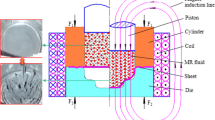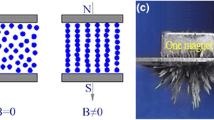Abstract
During the sheet flexible-die forming process using a magnetorheological (MR) fluid, the MR fluid is always subjected to a three-dimensional stress state, working in a combination of squeezing mode and valve mode. However, there is a lack of deep understanding of the stress-strain rate curve for MR fluids in the combined mode. In this paper, through extrusion test and finite element simulation, the mechanical properties of an MR fluid with a magnetic particle content of 43% and three kinds of viscous mediums used in viscous pressure forming (VPF) were compared and analyzed for the first time. It shows that the adjustment range of the MR fluid’s mechanical properties under different magnetic fields is much larger than that of a viscous medium with a molecular weight of 700 kg/mol. Besides, by changing the magnetic field, the mechanical property of an MR fluid can cover the mechanical properties of viscous mediums with different molecular weights. It is proved that the stress-strain rate curve of the MR fluid changes from a linear relationship to a power exponent one with the increase of magnetic flux density. Meanwhile, the strength coefficient increases, while the strain rate sensitivity index decreases. The obtained curves were applied to the numerical simulation of sheet flexible-die forming, which can well explain the experimental phenomena through the analysis of velocity, pressure, stress, and strain distribution. The results can provide theoretical guidance in the optimization of processing parameters in sheet flexible-die forming using an MR fluid.


















Similar content being viewed by others
Data availability
Not applicable.
Code availability
The simulation software Deform V11.0 is a commercially licensed product of Scientific Forming Technologies Corporation.
References
Rabinow J (1948) The magnetic fluid clutch. Trans Am Inst Electr Eng 67:1308–1315
Jolly MR, Bender JW, Carlson JD (1999) Properties and applications of commercial magnetorheological fluids. J Intell Mater Syst Struct 10:5–13
Carlson JD, Jolly MR (2000) MR fluid, foam and elastomer devices. Mechatronics 10(4-5):555–569
Carlson JD, Catanzarite DM, St. Clair KA (1996) Commercial magneto-rheological fluid devices. Int J Mod Phys B 10(23):2857–2865
Wereley NM, Cho JU, Choi YT, Choi SB (2008) Magnetorheological dampers in shear mode. Smart Mater Struct 17(1):015022
Spencer BF Jr, Dyke SJ, Sain MK, Carlson JD (1997) Phenomenological model for magnetorheological dampers. J Eng Mech 123(3):230–238
Wang Y, Luo Q, Liu H, Wu J, Li T (2019) Aggregated chain morphological variation analysis of magnetorheological fluid (MRF) in squeeze mode. Smart Mater Struct 28(10):105038
Ismail I, Mazlan SA, Zamzuri H, Olabi AG (2012) Fluid-particle separation of magnetorheological fluid in squeeze mode. Jpn J Appl Phys 51:067301
Fan X, Chen X, Lin Y, He ZB (2020) Research on the local formability of Al-Mg-Si alloy sheet during rapid hot gas forming. Int J Adv Manuf Technol 108:1839–1848
Zhu HH, He ZB, Lin YL, Zheng KL, Fan XB, Yuan SJ (2020) The development of a novel forming limit diagram under nonlinear loading paths in tube hydroforming. Int J Mech Sci 172:105392
Wang PY, Zhang WZ, Wang ZJ, Yi J (2016) Effect of viscosity of viscous medium on formability of Al1060-O sheet in viscous pressure forming (VPF): an experimental study. Int J Adv Manuf Technol 87:677–686
Lee J, Park H, Kim SJ, Kwon YN, Kim D (2018) Numerical investigation into plastic deformation and failure in aluminum alloy sheet rubber-diaphragm forming. Int J Mech Sci 142-143:112–120
Jia XD, Zhao CC (2019) The mechanical analysis of flexible die drawing for spherical parts based on weight function. Int J Adv Manuf Technol 102:659–671
Zhang CB, Gong F (2018) Deep drawing of cylindrical cups using polymer powder medium based flexible forming. Int J Pr Eng man-GT 5(1):63–70
Wang L, Li M (2019) Effects of wrinkling prevention forming method using paraffin on forming accuracy for 1060 aluminum sheet metal. Int J Mater Form 12:889–898
Chen H, Hess S, Haeberle J, Pitikaris S, Born P, Güner A, Sperl M, Tekkaya AE (2016) Enhanced granular medium-based tube and hollow profile press hardening[J]. Cirp Ann-Manuf Techn 65(1):273–276
Rösel S, Merklein M (2014) Improving formability due to an enhancement of sealing limits caused by using a smart fluid as active fluid medium for hydroforming. Prod Eng 8(1-2):7–15
Wang ZJ, Wang PY, Song H (2014) Research on sheet-metal flexible-die forming using a magnetorheological fluid. J Mater Process Technol 214(11):2200–2211
Liu Y, Li F, Li C, Xu J (2019) Enhancing formability of spherical bottom cylindrical parts with magnetic medium on deep drawing process. Int J Adv Manuf Technol 103:1669–1679
Wang PY, Wang ZJ, Xiang N, Li ZX (2020) Investigation on changing loading path in sheet metal forming by applying a property-adjustable flexible-die. J Manuf Process 53:364–375
Wang PY, Wang ZJ, Xiang N, Cai SP, Li ZX (2020) Mechanism of magnetic field condition on deformation behavior of sheet metal using a property-adjustable flexible-die. Int J Adv Manuf Technol 109:629–644
Khan SA, Suresh A, Seetharamaiah N. Principles (2014) Characteristics and applications of magneto rheological fluid damper in flow and shear mode. Procedia Mater Sci 6:1547-1556.
Yamamoto H, Nakano M (2002) Rheological properties and dynamic mechanical model of a magnetorheological suspension in pressure flow mode. Nihon Reoroji Gakk 30(2):83–88
Guo C, Gong X, Xuan S, Yan Q, Ruan X (2013) Squeeze behavior of magnetorheological fluids under constant volume and uniform magnetic field. Smart Mater Struct 22(4):045020
Stanway R, Sproston JL, Stevens NG (1987) Non-linear modelling of an electro-rheological vibration damper. J Electrost 20(2):167–184
Funding
This research is supported by the National Natural Science Foundation of China (No. 51805309, No. 51275130), Natural Science Basic Research Program of Shaanxi (Program No. 2019JQ-770), and Natural Science Foundation of Shaanxi University of Science and Technology (No. 2017BJ-14).
Author information
Authors and Affiliations
Contributions
Peng-yi Wang: methodology, investigation, writing - original draft, funding acquisition. Ge-hui Wan: investigation, writing - original draft. Zhong-jin Wang: methodology, writing - review and editing. Nan Xiang: writing -review and editing.
Corresponding author
Ethics declarations
Conflict of interest
The authors declare no competing interests.
Additional information
Publisher’s note
Springer Nature remains neutral with regard to jurisdictional claims in published maps and institutional affiliations.
Rights and permissions
About this article
Cite this article
Wang, Py., Wan, Gh., Wang, Zj. et al. Investigation on the stress-strain rate curve of MR fluids in a combined mode and its application in sheet flexible-die forming. Int J Adv Manuf Technol 117, 67–79 (2021). https://doi.org/10.1007/s00170-021-07301-1
Received:
Accepted:
Published:
Issue Date:
DOI: https://doi.org/10.1007/s00170-021-07301-1




